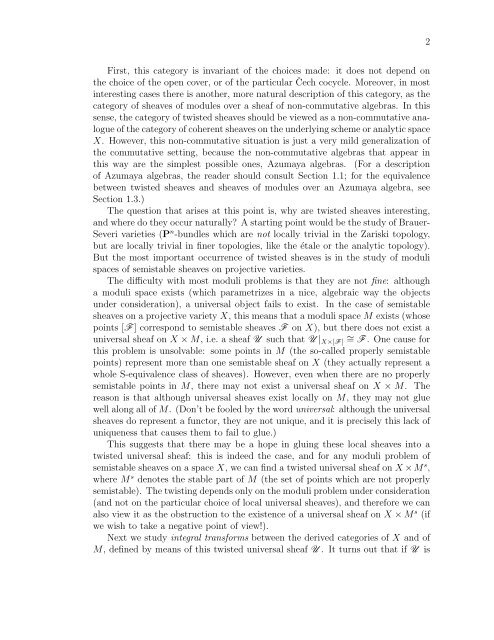derived categories of twisted sheaves on calabi-yau manifolds
derived categories of twisted sheaves on calabi-yau manifolds
derived categories of twisted sheaves on calabi-yau manifolds
You also want an ePaper? Increase the reach of your titles
YUMPU automatically turns print PDFs into web optimized ePapers that Google loves.
First, this category is invariant <str<strong>on</strong>g>of</str<strong>on</strong>g> the choices made: it does not depend <strong>on</strong><br />
the choice <str<strong>on</strong>g>of</str<strong>on</strong>g> the open cover, or <str<strong>on</strong>g>of</str<strong>on</strong>g> the particular Čech cocycle. Moreover, in most<br />
interesting cases there is another, more natural descripti<strong>on</strong> <str<strong>on</strong>g>of</str<strong>on</strong>g> this category, as the<br />
category <str<strong>on</strong>g>of</str<strong>on</strong>g> <str<strong>on</strong>g>sheaves</str<strong>on</strong>g> <str<strong>on</strong>g>of</str<strong>on</strong>g> modules over a sheaf <str<strong>on</strong>g>of</str<strong>on</strong>g> n<strong>on</strong>-commutative algebras. In this<br />
sense, the category <str<strong>on</strong>g>of</str<strong>on</strong>g> <str<strong>on</strong>g>twisted</str<strong>on</strong>g> <str<strong>on</strong>g>sheaves</str<strong>on</strong>g> should be viewed as a n<strong>on</strong>-commutative analogue<br />
<str<strong>on</strong>g>of</str<strong>on</strong>g> the category <str<strong>on</strong>g>of</str<strong>on</strong>g> coherent <str<strong>on</strong>g>sheaves</str<strong>on</strong>g> <strong>on</strong> the underlying scheme or analytic space<br />
X. However, this n<strong>on</strong>-commutative situati<strong>on</strong> is just a very mild generalizati<strong>on</strong> <str<strong>on</strong>g>of</str<strong>on</strong>g><br />
the commutative setting, because the n<strong>on</strong>-commutative algebras that appear in<br />
this way are the simplest possible <strong>on</strong>es, Azumaya algebras. (For a descripti<strong>on</strong><br />
<str<strong>on</strong>g>of</str<strong>on</strong>g> Azumaya algebras, the reader should c<strong>on</strong>sult Secti<strong>on</strong> 1.1; for the equivalence<br />
between <str<strong>on</strong>g>twisted</str<strong>on</strong>g> <str<strong>on</strong>g>sheaves</str<strong>on</strong>g> and <str<strong>on</strong>g>sheaves</str<strong>on</strong>g> <str<strong>on</strong>g>of</str<strong>on</strong>g> modules over an Azumaya algebra, see<br />
Secti<strong>on</strong> 1.3.)<br />
The questi<strong>on</strong> that arises at this point is, why are <str<strong>on</strong>g>twisted</str<strong>on</strong>g> <str<strong>on</strong>g>sheaves</str<strong>on</strong>g> interesting,<br />
and where do they occur naturally? A starting point would be the study <str<strong>on</strong>g>of</str<strong>on</strong>g> Brauer-<br />
Severi varieties (P n -bundles which are not locally trivial in the Zariski topology,<br />
but are locally trivial in finer topologies, like the étale or the analytic topology).<br />
But the most important occurrence <str<strong>on</strong>g>of</str<strong>on</strong>g> <str<strong>on</strong>g>twisted</str<strong>on</strong>g> <str<strong>on</strong>g>sheaves</str<strong>on</strong>g> is in the study <str<strong>on</strong>g>of</str<strong>on</strong>g> moduli<br />
spaces <str<strong>on</strong>g>of</str<strong>on</strong>g> semistable <str<strong>on</strong>g>sheaves</str<strong>on</strong>g> <strong>on</strong> projective varieties.<br />
The difficulty with most moduli problems is that they are not fine: although<br />
a moduli space exists (which parametrizes in a nice, algebraic way the objects<br />
under c<strong>on</strong>siderati<strong>on</strong>), a universal object fails to exist. In the case <str<strong>on</strong>g>of</str<strong>on</strong>g> semistable<br />
<str<strong>on</strong>g>sheaves</str<strong>on</strong>g> <strong>on</strong> a projective variety X, this means that a moduli space M exists (whose<br />
points [F ] corresp<strong>on</strong>d to semistable <str<strong>on</strong>g>sheaves</str<strong>on</strong>g> F <strong>on</strong> X), but there does not exist a<br />
universal sheaf <strong>on</strong> X × M, i.e. a sheaf U such that U |X×[F] ∼ = F . One cause for<br />
this problem is unsolvable: some points in M (the so-called properly semistable<br />
points) represent more than <strong>on</strong>e semistable sheaf <strong>on</strong> X (they actually represent a<br />
whole S-equivalence class <str<strong>on</strong>g>of</str<strong>on</strong>g> <str<strong>on</strong>g>sheaves</str<strong>on</strong>g>). However, even when there are no properly<br />
semistable points in M, there may not exist a universal sheaf <strong>on</strong> X × M. The<br />
reas<strong>on</strong> is that although universal <str<strong>on</strong>g>sheaves</str<strong>on</strong>g> exist locally <strong>on</strong> M, they may not glue<br />
well al<strong>on</strong>g all <str<strong>on</strong>g>of</str<strong>on</strong>g> M. (D<strong>on</strong>’t be fooled by the word universal: although the universal<br />
<str<strong>on</strong>g>sheaves</str<strong>on</strong>g> do represent a functor, they are not unique, and it is precisely this lack <str<strong>on</strong>g>of</str<strong>on</strong>g><br />
uniqueness that causes them to fail to glue.)<br />
This suggests that there may be a hope in gluing these local <str<strong>on</strong>g>sheaves</str<strong>on</strong>g> into a<br />
<str<strong>on</strong>g>twisted</str<strong>on</strong>g> universal sheaf: this is indeed the case, and for any moduli problem <str<strong>on</strong>g>of</str<strong>on</strong>g><br />
semistable <str<strong>on</strong>g>sheaves</str<strong>on</strong>g> <strong>on</strong> a space X, we can find a <str<strong>on</strong>g>twisted</str<strong>on</strong>g> universal sheaf <strong>on</strong> X × M s ,<br />
where M s denotes the stable part <str<strong>on</strong>g>of</str<strong>on</strong>g> M (the set <str<strong>on</strong>g>of</str<strong>on</strong>g> points which are not properly<br />
semistable). The twisting depends <strong>on</strong>ly <strong>on</strong> the moduli problem under c<strong>on</strong>siderati<strong>on</strong><br />
(and not <strong>on</strong> the particular choice <str<strong>on</strong>g>of</str<strong>on</strong>g> local universal <str<strong>on</strong>g>sheaves</str<strong>on</strong>g>), and therefore we can<br />
also view it as the obstructi<strong>on</strong> to the existence <str<strong>on</strong>g>of</str<strong>on</strong>g> a universal sheaf <strong>on</strong> X × M s (if<br />
we wish to take a negative point <str<strong>on</strong>g>of</str<strong>on</strong>g> view!).<br />
Next we study integral transforms between the <str<strong>on</strong>g>derived</str<strong>on</strong>g> <str<strong>on</strong>g>categories</str<strong>on</strong>g> <str<strong>on</strong>g>of</str<strong>on</strong>g> X and <str<strong>on</strong>g>of</str<strong>on</strong>g><br />
M, defined by means <str<strong>on</strong>g>of</str<strong>on</strong>g> this <str<strong>on</strong>g>twisted</str<strong>on</strong>g> universal sheaf U . It turns out that if U is<br />
2
















